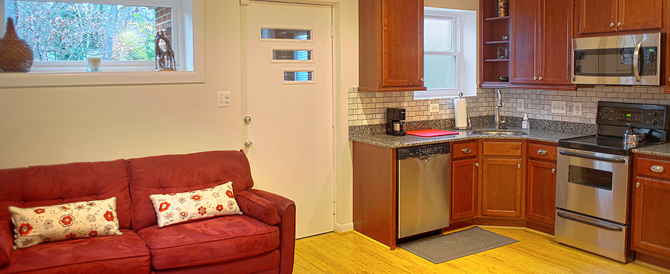According to the U.S. Census Bureau, multi-generational households have become more and more prevalent in the United States, having risen nearly 30% between 2000 and 2010. Things such as lost retirement nest eggs, longer lifespans, and the cost of assisted living have all contributed to this rise in shared-living.
In a recent AARP survey of the baby boomer generation:
- 24% of those surveyed anticipate that their parents or in-laws will move in with them at some point in the future, and about one-half said that they would be happy to have their parents/in-laws live with them,
- 51% of those surveyed said that they would feel obligated to help in their parent’s retirement, and
- 17% of those surveyed said that they would be eager to find their parents/in-laws another living situation.
More and more, homeowners are opting for converting their houses into multi-generational homes for themselves, their children, and their aging parents. If you’re in a situation where you’re thinking about welcoming parents or in-laws into your home, here are three options for adding an in-law suite.
Option #1 – Convert a garage or basement into a living space.
Converting an existing garage or unfinished basement into a living space can be more practical and cost effective than adding on an addition to your home. Since most of the framework (foundation, walls, roof, etc.) is already in place, this option creates a solution without altering the exterior aesthetics of the home.
Keep in mind that this type of conversion will add to the square footage of your home and may require proper zoning approval and an increase in your homeowner’s insurance. Be sure to research thoroughly before committing. In addition, special considerations like mobility for elderly parents, accessibility to the rest of the home and privacy must be taken into account.
Option #2 – Adding new rooms in an addition.
In many cases, adding on addition to accommodate the living space for aging parents can provide just the right balance of privacy, while still fostering interaction between everyone in the home. Most families who decide on the multi-generational living situation don’t really want a separate existence, and often times the in-law suite is for a family member who has accessibility needs and requires lots of attention.
As with converting a garage or basement, building an addition also has shared walls with an expansion of the existing foundation, but also the advantage of first-floor access for special needs family members.
Option #3 – Building a stand-alone structure.
Building an auxiliary structure on your property is the least cost-effective method of adding an in-law suite, primarily because nothing is shared. Insulation, exterior walls, foundation, plumbing, and electrical all must be set up separately from the existing home to support the new living space.
With that said, a stand-alone structure does provide the most privacy, independence and security for those living in the addition.
Whatever living option works best for your family, working with a licensed and bond contractor/remodeler is essential. The expertise required for such projects is more that the average do-it-yourselfer can handle – especially considering that this will be a living space for your family members.
If you are ready to move forward, contact us today and schedule a free estimate. In our meeting we can go over, in detail, which option would work best for you and your family.

